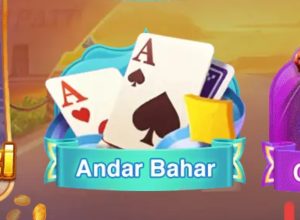is a popular mobile card game based on the traditional Indian game *Teen Patti*, which translates to “three cards” and is similar to poker. In *Teen Patti Gold*, players aim to have the best three-card hand or bluff their way to victory.
Key Features:
1. Multiplayer Gameplay
Players can join online tables with friends or other players worldwide.
2. Variations
It includes several variations like Classic Teen Patti Joker Muflis*, and more.
3. Chips and Betting
Players bet chips during each round, and the pot grows as the game progresses. You can either play for fun with virtual chips or purchase them through in-app transactions.
4. Tournaments and Events
The game often hosts special tournaments and events for competitive players.
5. Social Features
Players can chat with others, send gifts, and even connect via social media.
It’s available on both Android and iOS platforms and is free to download, with optional in-app purchases. The game is designed to be fun and fast-paced, appealing to fans of card games and those looking for a social gaming experience.
is a blend of two popular Indian card games: *Teen Patti* (3 Patti) and *Rummy*. Both games have different rules but share similarities in how they involve strategic thinking, bluffing, and arranging cards.
Here’s a brief overview of both games and how they might intersect in a hybrid version like 3 Patti Rummy
Teen Patti (3 Patti) Overview
1. Objective
Players are dealt three cards, and the goal is to have the best hand or successfully bluff opponents into folding.
2. Ranking of Hands
Hands are ranked similar to poker, with combinations like *Trail (Three of a Kind)*, *Straight Run*, *Flush*, etc.
3. **Gameplay**: Players place bets into a pot, and each round ends when all but one player folds or when the best hand is revealed.
Rummy Overview
Three or four cards of the same rank but different suits.
– *Sequences*: Consecutive cards of the same suit.
3. **Gameplay Players draw and discard cards, trying to organize their hands into valid sets/sequences before others.
How 3 Patti Rummy Works
-Objective
Players could be asked to form valid three-card sequences or sets from the cards dealt, while also incorporating elements of betting like in Teen Patti.
– **Betting**: Similar to Teen Patti, betting is likely a key feature. Players can raise, call, or fold depending on their confidence in their hand.
This combination brings together the strategic depth of Rummy and the fast-paced bluffing and betting of Teen Patti, making for a fun and challenging game.
Teen Patti Gold 3 Patti Rummy
asic Rules of Teen Patti
1. Number of Players
– The game is usually played by 3 to 6 players.
2. Objective
– The goal is to have the best three-card hand, or to bluff other players into folding.
3. Gameplay
– **Dealer**: One player is chosen as the dealer, who shuffles the cards and deals them face-down to each player.
– **Ante/Boot**: Before the game starts, each player places a fixed amount into the pot. This is called the *boot* or *ante*.
-Blind vs Seen
– Players can either play *blind* (without looking at their cards) or *seen* (after looking at their cards).
– Blind players must bet a fixed amount and can’t see their own cards, while seen players must bet at least twice the blind bet.
– Betting
– The betting begins with the player to the left of the dealer and continues clockwise.
– Players can *bet* (raise the stake) or *fold* (quit the round).
-Showdown
If two players remain, they can choose to have a *showdown*, where both players reveal their cards, and the player with the best hand wins the pot.
4. **Hand Rankings** (from highest to lowest):
– **Trail/Trio**: Three cards of the same rank (e.g., three aces).
– **Pure Sequence**: Three consecutive cards of the same suit (e.g., 2-3-4 of hearts).
– **Sequence**: Three consecutive cards of different suits (e.g., 4-5-6 of different suits).
– **Color/Flush**: Three cards of the same suit, not in sequence.
– **Pair/Double**: Two cards of the same rank (e.g., two kings).
– **High Card**: If no other hand is achieved, the highest card wins.
5. Bluffing
– Similar to poker, bluffing is a key part of Teen Patti. Players may bet high or confidently even with weak hands to make their opponents fold.
Game Variations
– There are several variations of Teen Patti, like *Joker*, *Muflis*, *AK47*, and *999*, where rules and hand rankings may vary slightly to keep the game interesting.
Chips and Betting
– Teen Patti can be played for fun with virtual or real chips, or with actual money in more traditional or competitive settings.
It’s a social and exciting game that involves both skill and luck, and its simplicity makes it easy for anyone to join and enjoy!
Rummy
is a popular card game that revolves around forming sets and sequences from a given hand of cards. It is typically played with 2 to 6 players using one or two standard decks of cards, depending on the variation. The main goal in Rummy is to arrange all the cards in your hand into valid sets or sequences.
Basic Rules of Rummy
1. Objective
– The aim is to form valid *sets* and *sequences* from the cards you have.
– A **set** consists of 3 or 4 cards of the same rank but different suits (e.g., 7♦, 7♣, 7♥).
– A **sequence** (also known as a run) is a group of 3 or more consecutive cards of the same suit (e.g., 4♦, 5♦, 6♦).
2. Number of Players
– Rummy is typically played by 2 to 6 players.
3. Number of Cards
– Each player is dealt a specific number of cards at the start of the game, usually 13 cards for each player in Indian Rummy.
4. Deck
– A standard deck of 52 cards is used for 2 players, and for 4 to 6 players, two decks (including jokers) may be used.
5. Joker
– The Joker can be used as a wildcard to substitute any missing card in a set or sequence.
Gameplay
1. Dealing
– The dealer shuffles the deck and deals 13 cards to each player (in Indian Rummy) or fewer cards depending on the variation.
– The remaining cards are placed face down in the center, forming the *draw pile*.
– The top card from the deck is placed face-up to start the *discard pile*.
2. Turn
– On each player’s turn, they can either:
– **Draw** a card from the draw pile or pick the top card from the discard pile.
– **Discard** one card from their hand to the discard pile.
3. **Forming Sets and Sequences**:
– Players must aim to form valid sets or sequences with their cards.
– In **Indian Rummy**, at least one sequence must be a pure sequence (without using a Joker).
– Other sequences can be pure or impure (using jokers).
4. Declaring
– When a player forms valid sets and sequences with all their cards, they can declare the hand. After declaring, their hand is checked for correctness.
– If valid, that player wins the round.
5. Scoring
– The losing players’ points are calculated based on the ungrouped cards left in their hand. Face cards (King, Queen, Jack) and Ace carry 10 points each, and other cards carry their face value.
– The player with the lowest score at the end of the game wins.
Key Terms
– **Pure Sequence**: A sequence without a joker (e.g., 5♠, 6♠, 7♠).
– **Impure Sequence**: A sequence formed using a joker (e.g., 5♠, Joker, 7♠).
– **Meld**: Arranging cards into sets or sequences.
– **Drop**: If a player feels they have a bad hand, they can “drop” and reduce their score.
Popular Variations of Rummy
1. **Indian Rummy
– Played with 13 cards and 2 or more decks.
– The goal is to form sequences and sets, and at least one sequence must be a pure sequence.
2. Gin Rummy
– Played with 10 cards, and the goal is to form sets and runs.
– Players try to reduce their deadwood (unmatched cards) to as low as possible before knocking (ending the round).
3. Kalooki Rummy
– Played with multiple jokers and involves slightly more complex rules, including penalties for unplayed cards.
4. 500 Rummy
– Played with the objective of reaching 500 points. Players can “lay off” cards on existing sets or runs from other players.
Rummy is a blend of strategy, skill, and a bit of luck, making it enjoyable for players of all ages and skill levels. It’s played casually among friends and family, but also competitively in tournaments.
*Andar Bahar

is a simple and fast-paced traditional Indian card game that is very popular due to its straightforward rules and quick rounds. It is a game of pure chance, making it fun and unpredictable for players.
Objective of Andar Bahar
The goal of the game is to correctly predict which side—*Andar* (inside) or *Bahar* (outside)—the matching card will appear on.
Teen Patti Gold 3 Patti Rummy
How to Play
1. Number of Players
– The game can be played with multiple players, but it’s typically one player versus the dealer.
2. Deck
– A standard deck of 52 cards is used without jokers.
3. Dealing
– The dealer shuffles the deck and draws one card from the deck, known as the **”Joker”** or **”House Cardwhich is placed face-up in the center of the table.
– The remaining cards are then used to continue the game.
4. Placing Bets
– Before the cards are dealt, players place bets on whether the matching card (the card with the same rank as the Joker) will appear on the **Andar** side (inside) or **Bahar** side (outside).
– *Andar* means inside, and *Bahar* means outside.
5. Card Dealing
– The dealer starts dealing cards alternately to the Andar and Bahar sides, starting with either Andar or Bahar (depending on the version of the game).
– The dealing continues until a card that matches the rank of the Joker card is dealt.
6. Outcome
– The game ends when a card matching the rank of the Joker is drawn.
– If the matching card appears on the side the player bet on (Andar or Bahar), they win the bet.
– If it appears on the opposite side, they lose.
Betting Rules
– Players can typically bet on either Andar or Bahar.
– In some versions of the game, additional side bets or bonus bets may be allowed, offering different payouts based on the number of cards dealt or other factors.
Example
–
– The dealer starts dealing cards alternately to Andar and Bahar.
– If the first matching 7 (of any suit) appears on Andar, players who bet on Andar win; if it appears on Bahar, players who bet on Bahar win.
Winning Payout
– The payout structure may vary depending on the platform or the house rules. Typically, the payout for betting on Andar or Bahar is close to 1:1, but the side that gets dealt first may have a slightly lower payout to balance the odds.
Game Variations
Some versions of Andar Bahar might offer additional betting options, such as:
– Betting on the number of cards that will be dealt before the matching card appears.
– Bonus bets with higher payouts for special hands.
Summary
Andar Bahar is a simple, exciting game that relies entirely on luck. It’s easy to learn and play, which makes it a favorite among casual players, both offline and in online casinos.


